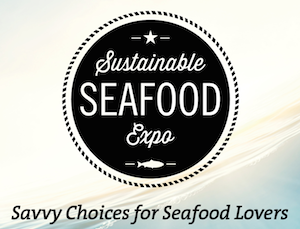
Born and raised in Hawaii, Chef Sam Choy explains how the islanders would watch the old Hawaiian “landkeepers” take care of the environment, and how they would embrace the magic of kapu.
Kapu represents a period of time when there is no fishing, no taking from the earth. “It is when we leave the earth time to replenish itself,” Choy said. “If we keep depleting, there will be nothing left for our great great grandkids. We need to protect. We need to care. We want them to have what we are enjoying.”
Choy’s philosophy has always been like that – protecting, caring. He lives that way, he says. Keeping the ocean pristine and vibrant, allowing the nature of the ocean to be plentiful. “Living in Hawaii, you have to believe in that, we are surrounded by water, after all.”
This post is the third in a series promoting sustainable seafood.
Sam Choy’s Bow-tie Mahimahi Salad
Crusted Ahi with Roasted Garlic Tahini
Working to not deplete any species of fish, the Chef discovered that the folks across the ocean at the Monterey Bay Aquarium had been doing a great job informing the public about sustainability issues. He was invited to be a part of their project 4 years ago. And recently, when the opportunity came about to promote seafood sustainability in Southern California, he was happy to come to San Pedro to extend the message. He says, “If we allow that to be a part of our daily life and livelihood, it will be there for the future generations.”
Known as the “Godfather of Poke,” Choy loves working with fresh fish and keeping it simple. The word poke (pronounced PO-kay) describes the method of preparation by cutting into cubes or slicing. Fish, vegetables, and even tofu – can all become poke. Choy is famous for making poke super-popular in the Islands when in 1991 he and a friend sponsored the first poke contest on the Big Island.
Long before Captain Cook “discovered” Hawaii, islanders were eating poke. Reef fish would be cut up and seasoned with sea salt collected from evaporated pockets of sea water along the shore. Then limu (seaweed) and inamona (ground candlenut) were mixed in. Later, Hawaiians started growing chili peppers. Around 200 years ago, they enthusiastically adopted this new spicy taste, and added chili pepper to the traditional poke recipe.
The old-style poke is still very much enjoyed today. But as Hawaii became a melting pot for various cultures and cuisines, poke has undergone an exotic evolution. Choy and his contemporaries have been creating a new wave of poke dishes. Peanut butter, lemongrass, macadamia nuts and other novel ingredients are mixed with fish putting a cutting-edge twist on the old simple but delicious pokes of the past.
At the Sustainable Seafood Expo hosted by the Cabrillo Marine Aquarium held at Crafted at the Port of Los Angeles on October 12th, Choy demonstrated two classic, fresh, and fabulous poke dishes – one with pole-caught yellowfin tuna (ahi), the other with avocado.
Pole-caught, Pacific yellowfin tuna is rated “best choice” by Seafood Watch, a site that recommends which seafood to buy or avoid, to help consumers and chefs alike in selecting items that are fished or farmed in ways that have less impact on the environment. The Seafood Watch smartphone app is a free handy device to bring consumers up-to-date recommendations for ocean-friendly seafood and sushi.
In addition to raw preparations, poke can also be cooked. In Chef Sam Choy’s Bow-tie Mahimahi Salad, the fish is cut into cubes and pan-seared for about a minute. Tossed with a lemony cilantro mayonnaise and vegetables – it is a pasta salad made with readily available ingredients and has broad appeal. Be sure to check out his original recipe here. It is another sustainable seafood dish, wild mahimahi caught by longline off the U.S. coast is rated a “good alternative” by Seafood Watch.
Mahalo Chef! Mahalo.
(From my column in Random Lengths News, October 16 – 29, 2014 issue).


6 thoughts on “My Interview with Chef Sam Choy on Sustainability and Poke!”